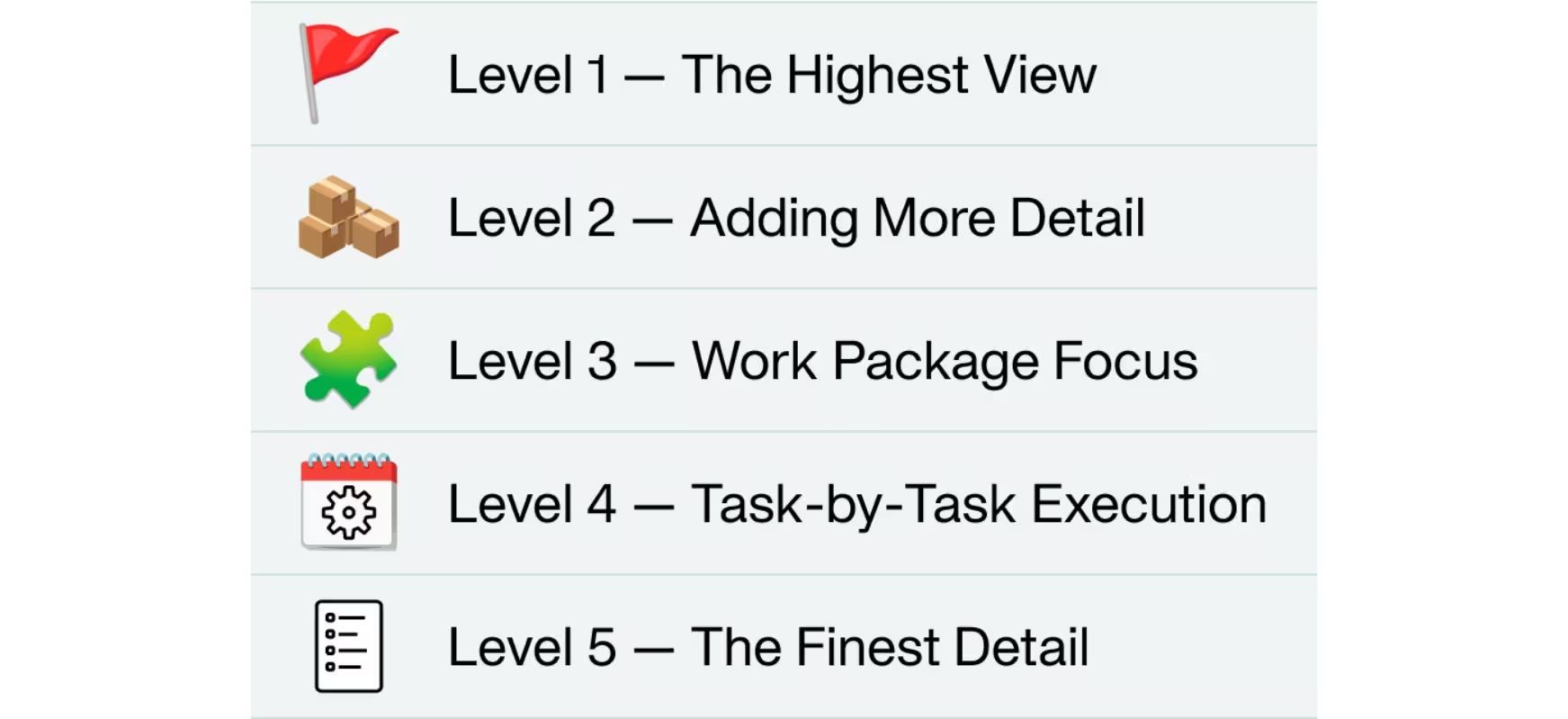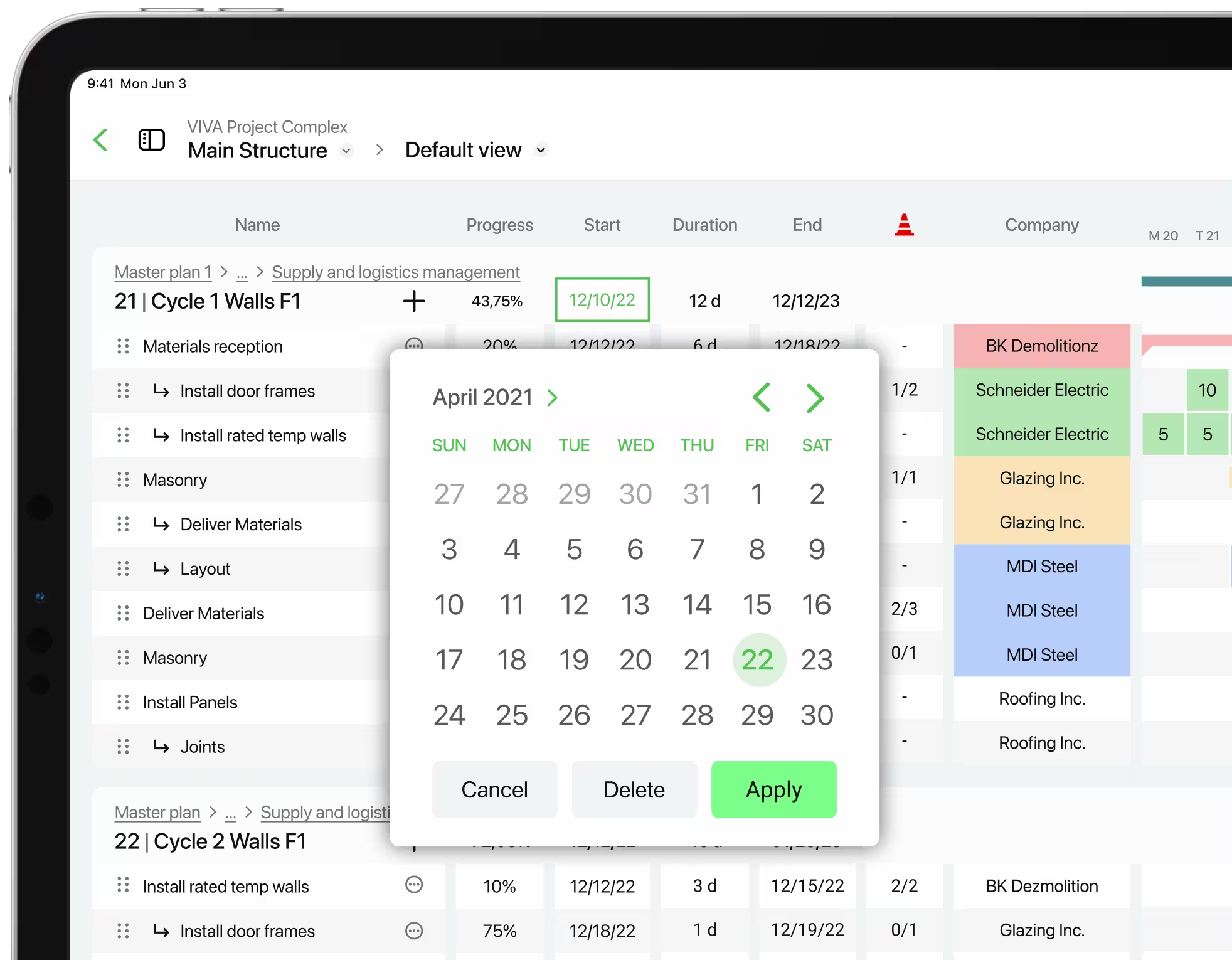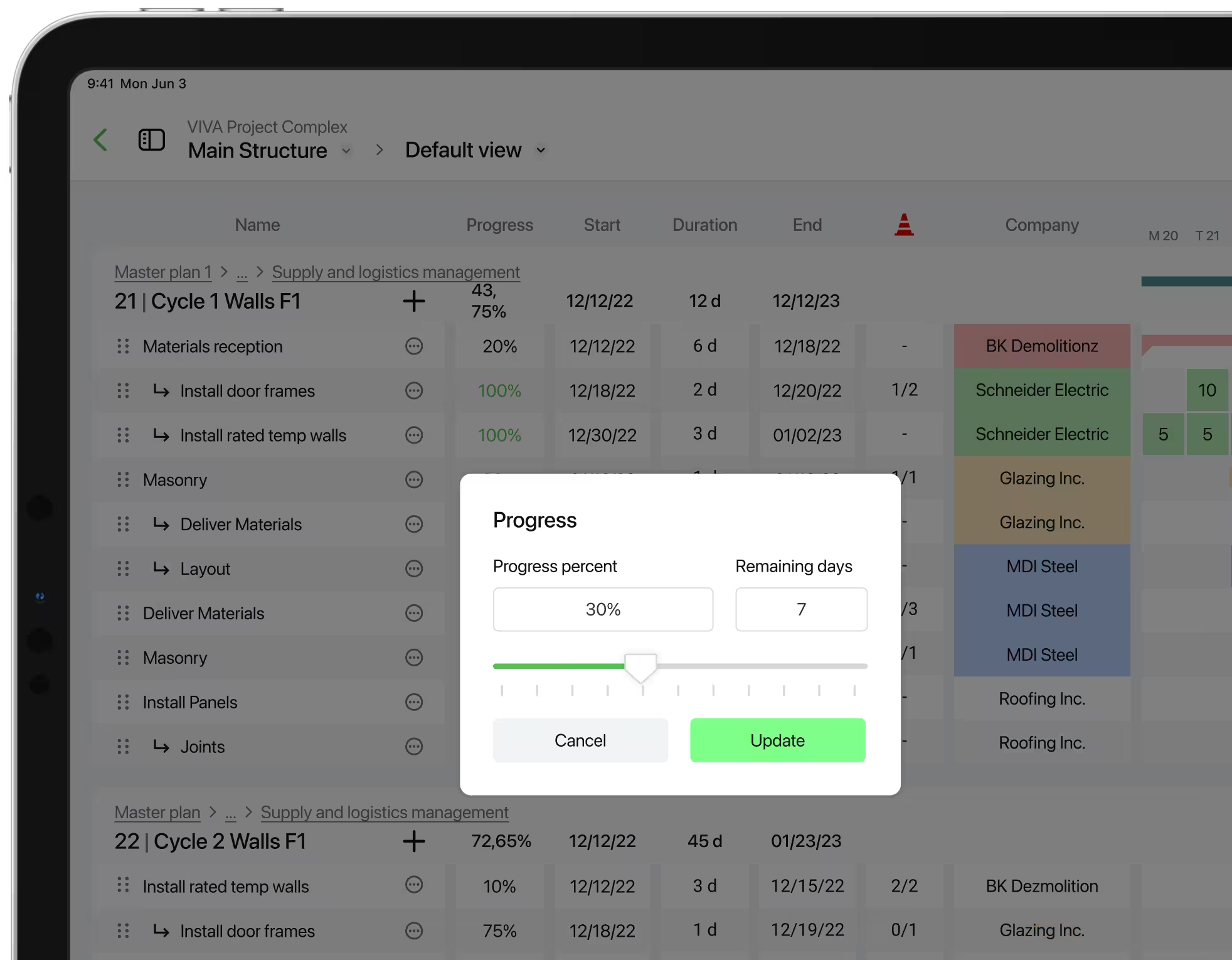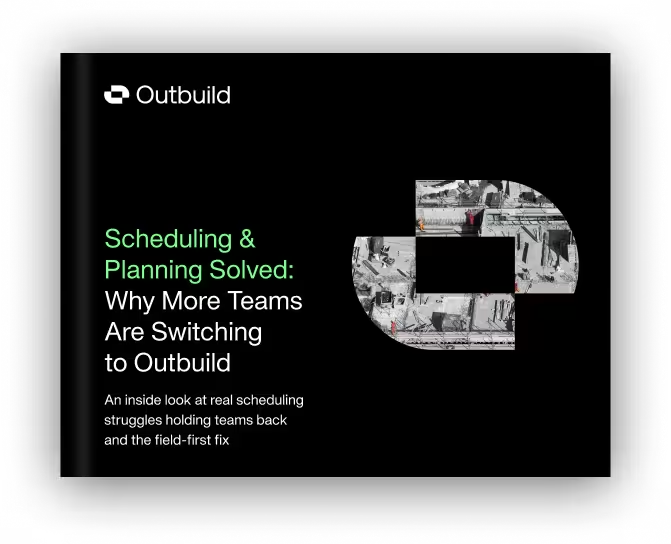Outbuild is online scheduling software to work together on connected project schedules and look-aheads, enabling everyone to move faster.
Key Takeaways
Table of contents
- Why Project Schedule Levels Matter
- Overview of Schedule Levels in Construction Projects
- Level 1 Schedule – The Highest View
- Level 2 Schedule – Adding More Detail
- Level 3 Schedule – Work Package Focus
- Level 4 Schedule – Task-by-Task Execution
- Level 5 Schedule – The Finest Detail
- Choosing the Right Level for Your Project
- Tips & Best Practices for Implementation
- Leverage Schedule Levels to Be Productive
Managing a construction project successfully often comes down to how well you plan and track every stage. That’s where project schedules come in.
There are different levels of scheduling and they help teams with successful construction project execution.
By knowing about construction schedule levels and how they differ in project schedules, you can use the right details at the right time. This keeps projects on track, on budget, and under control.

Project schedule levels matter because they help you organize complex tasks in a clear, structured way.
High-level schedules give a big picture of project scope and goals. They are important for executives and senior stakeholders. A high-level construction project schedule shows key milestones and tasks clearly. It helps you see important parts of the project at a glance.
By starting with broad objectives, you can make informed decisions about resource allocation, timelines, and risks. Then, as you move into different levels of project schedule, you refine those details. This approach offers flexibility and clarity for everyone involved.
In the construction industry, scheduling is often discussed in terms of construction schedule levels.
The idea is simple: each level shows more detail. A level 1 schedule gives a broad overview. A level 5 schedule breaks down daily tasks in detail.

These schedule levels ensure that each role has the right information. This includes roles like superintendent, project manager, and field crew. This helps them do their jobs effectively.
When you’re managing project schedules, particularly at Level 2 and beyond, Gantt charts become an invaluable tool. A Gantt chart offers a visual timeline of tasks, showing their start and finish dates, duration, and dependencies. This helps managers and teams quickly see what needs to happen when, and where delays could impact downstream activities.
This roadmap helps team members coordinate, avoid rework, and deliver results on time.
People commonly structure and track milestones to help connect the dots from planning to completion.
A level 1 schedule is also called a level 1 project schedule or a level 1 construction schedule. It highlights major milestones.
It briefly outlines the project’s start and end dates, major phases, and critical deliverables. Think of it as a birds-eye view for executives or high-level stakeholders who need fast updates.
Level 1 project schedule example:
A level one project schedule should show your construction project broken down into phases.
For example, a level 1 schedule could incorporate the below, along with associated time durations:
- Site Preparation
- Foundation Work
- Structural Construction
- Turnover
A level 1 project schedule usually doesn’t detail individual tasks. Instead, it focuses on the key steps that define project progress.
Moving one layer deeper, a level 2 project schedule provides an overview of major work packages under each phase.
In a level 2 construction schedule, you see big tasks grouped together. For example, Foundation Work is divided into excavation, formwork, and concrete pouring.
Level 2 project schedule example:
A level 2 schedule helps managers and functional leads with resource management. While it’s not detailed enough for daily management, it helps departments plan for important tasks. It also keeps the larger project goals clear.
At level 3, the schedule zeroes in on the tasks within each work package. A level 3 schedule shows each deliverable in a phase. It includes the duration and how it links to the next tasks.
A level 3 construction schedule shows important goals for smaller teams. These goals need to be met in every weekly work plan or at least every two weeks.
Level 3 project schedule example:
A level 3 schedule allows a team to see detailed activities tied to each package. Subcontractors and supervisors work together to align their teams with the project's goals. They make sure daily tasks lead to real progress for the whole project.
To better understand how daily and weekly planning helps with on-site work, check out the lookahead schedule in construction. This method can greatly affect short-term productivity.
When a project needs more control, a level 4 project schedule shows each task and its dependencies. At this level, you include daily or weekly tasks for on-site teams.
Level 4 project schedule example:
A level 4 construction schedule shows how many labor hours you need each day. It also shows which materials must arrive before starting a certain activity.
For superintendents and construction managers, a level 4 schedule ensures no detail slips through the cracks. It improves coordination, clarifies who is responsible for each task, and prevents costly delays.
What is a level 5 schedule? It is the most granular. This level breaks down each day’s tasks by specific crew activities.
Level 5 project schedule example:
For large-scale projects, a level 5 schedule can help managers meticulously oversee daily labor, equipment, and materials.
Not every project requires a level 5 schedule. However, it is a strong tool for complex tasks. Teams may feel that tracking every small step is important. In these special cases, it helps reduce downtime, optimize workforce allocation, and maintain ultimate transparency.
Selecting the appropriate layers within the levels of project schedule depends on factors like scope, complexity, and stakeholder requirements.
It is important to find a construction scheduling and planning software that has a combination of a few of these levels.

You want software that can address all of these levels. With Outbuild, you can start with a simple project schedule to align everyone involved. Then, you can easily look at Level 2, 3, or even Level 5 views as the project moves forward—all in one platform. It’s dynamic, to fit your needs.
Making an informed choice about project schedule levels ensures alignment between strategic objectives and day-to-day operations. Decide early how detailed your schedule should be. Then add more details as your project grows or as stakeholders ask for more information.
- Leverage scheduling tools that manage everything from high level schedule project management down to the most detailed tasks.
Hint: To explore which solutions can streamline your planning process, see this comparison of top construction scheduling software. - Make sure communication flows consistently across all construction schedule levels so teams understand which deliverables they own.
- Start with a broad schedule within a high level project plan. Then, refine your plan step by step. This will help you reach the needed detail.
- Review and update schedules regularly to ensure they reflect actual progress and changing conditions.
These practices help you avoid confusion. They promote accountability and keep every stakeholder informed, no matter their schedule level.

Learning to manage project schedules is important. Mastering these levels can help you manage timelines better and is better for tracking progress. It can also help you allocate resources effectively and achieve project success.
Choosing the right method is important for your construction project and your project team. It helps keep your goals clear. It also keeps your team productive. You can look at a big project schedule or focus on the details in a level 5 schedule.
It also allows for team members to successfully monitor progress and review specific tasks.

By using software to improve your construction scheduling, you will help your team handle any challenge. This includes both big milestones and small daily tasks.
For teams wanting to improve scheduling, using the best construction scheduling software can make a big difference. It helps with both overall and detailed planning. Try Outbuild free for 14 days—no credit card required. Or, schedule a demo to learn more.
At level 3, the schedule zeroes in on the tasks within each work package. A level 3 schedule shows each deliverable in a phase. It includes the duration and how it links to the next tasks.
A level 3 construction schedule shows important goals for smaller teams. These goals need to be met in every weekly work plan or at least every two weeks.
Level 3 project schedule example:
A level 3 schedule allows a team to see detailed activities tied to each package. Subcontractors and supervisors work together to align their teams with the project's goals. They make sure daily tasks lead to real progress for the whole project.
To better understand how daily and weekly planning helps with on-site work, check out the lookahead schedule in construction. This method can greatly affect short-term productivity.
When a project needs more control, a level 4 project schedule shows each task and its dependencies. At this level, you include daily or weekly tasks for on-site teams.
Level 4 project schedule example:
A level 4 construction schedule shows how many labor hours you need each day. It also shows which materials must arrive before starting a certain activity.
For superintendents and construction managers, a level 4 schedule ensures no detail slips through the cracks. It improves coordination, clarifies who is responsible for each task, and prevents costly delays.
What is a level 5 schedule? It is the most granular. This level breaks down each day’s tasks by specific crew activities.
Level 5 project schedule example:
For large-scale projects, a level 5 schedule can help managers meticulously oversee daily labor, equipment, and materials.
Not every project requires a level 5 schedule. However, it is a strong tool for complex tasks. Teams may feel that tracking every small step is important. In these special cases, it helps reduce downtime, optimize workforce allocation, and maintain ultimate transparency.
Selecting the appropriate layers within the levels of project schedule depends on factors like scope, complexity, and stakeholder requirements.
It is important to find a construction scheduling and planning software that has a combination of a few of these levels.

You want software that can address all of these levels. With Outbuild, you can start with a simple project schedule to align everyone involved. Then, you can easily look at Level 2, 3, or even Level 5 views as the project moves forward—all in one platform. It’s dynamic, to fit your needs.
Making an informed choice about project schedule levels ensures alignment between strategic objectives and day-to-day operations. Decide early how detailed your schedule should be. Then add more details as your project grows or as stakeholders ask for more information.
- Leverage scheduling tools that manage everything from high level schedule project management down to the most detailed tasks.
Hint: To explore which solutions can streamline your planning process, see this comparison of top construction scheduling software. - Make sure communication flows consistently across all construction schedule levels so teams understand which deliverables they own.
- Start with a broad schedule within a high level project plan. Then, refine your plan step by step. This will help you reach the needed detail.
- Review and update schedules regularly to ensure they reflect actual progress and changing conditions.
These practices help you avoid confusion. They promote accountability and keep every stakeholder informed, no matter their schedule level.

Learning to manage project schedules is important. Mastering these levels can help you manage timelines better and is better for tracking progress. It can also help you allocate resources effectively and achieve project success.
Choosing the right method is important for your construction project and your project team. It helps keep your goals clear. It also keeps your team productive. You can look at a big project schedule or focus on the details in a level 5 schedule.
It also allows for team members to successfully monitor progress and review specific tasks.

By using software to improve your construction scheduling, you will help your team handle any challenge. This includes both big milestones and small daily tasks.
For teams wanting to improve scheduling, using the best construction scheduling software can make a big difference. It helps with both overall and detailed planning. Try Outbuild free for 14 days—no credit card required. Or, schedule a demo to learn more.
Frequently Asked Questions
Related Articles
Ready to see Outbuild?
Join hundreds of contractors from 10+ countries that are saving money by scheduling better










